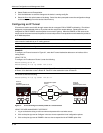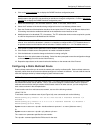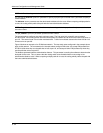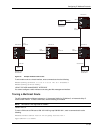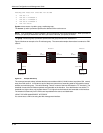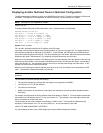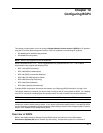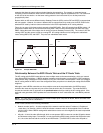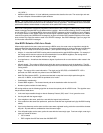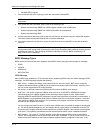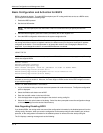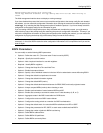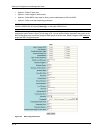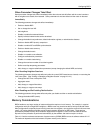
Advanced Configuration and Management Guide
networks that share the same routing and administration characteristics. For example, a corporate intranet
consisting of several networks under common administrative control might be considered an AS. The networks in
an AS can but do not need to run the same routing protocol to be in the same AS, nor do they need to be
geographically close.
Routers within an AS can use different Interior Gateway Protocols (IGPs) such as RIP and OSPF to communicate
with one another. However, for routers in different ASs to communicate, they need to use an EGP. BGP4 is the
standard EGP used by Internet routers and therefore is the EGP implemented on HP routing switches.
Figure 10.1 on page 10-2 shows a simple example of two BGP4 ASs. Each AS contains three BGP4 routers. All
of the BGP4 routers within an AS communicate using IBGP. BGP4 routers communicate with other ASs using
EBGP. Notice that each of the routers also is running an Interior Gateway Protocol (IGP). The routers in AS1 are
running OSPF and the routers in AS2 are running RIP. HP routing switches can be configured to redistribute
routes among BGP4, RIP, and OSPF. They also can redistribute static routes.
EBGP
RIP
IBGP
IBGP
IBGP
IBGP
AS 2
AS 1
IBGP
IBGP
OSPF
RIP
OSPF OSPF
RIP
Figure 10.1 Example BGP4 ASs
Relationship Between the BGP4 Route Table and the IP Route Table
The HP routing switch’s BGP4 route table can have multiple routes to the same destination, which are learned
from different BGP4 neighbors. A BGP4 neighbor is another router that also is running BGP4. BGP4 neighbors
communicate using Transmission Control Protocol (TCP) port 179 for BGP communication. When you configure
the HP routing switch for BGP4, one of the configuration tasks you perform is to identify the routing switch’s BGP4
neighbors.
Although a router’s BGP4 route table can have multiple routes to the same destination, the BGP4 protocol
evaluates the routes and chooses only one of the routes to send to the IP route table. The route that BGP4
chooses and sends to the IP route table is the preferred route and will be used by the HP routing switch. If the
preferred route goes down, BGP4 updates the route information in the IP route table with a new BGP4 preferred
route.
NOTE: If IP load sharing is enabled and you enable multiple equal-cost paths for BGP4, BGP4 can select more
than one equal-cost path to a destination.
A BGP4 route consists of the following information:
• Network number (prefix) – A value comprised of the network mask bits and an IP address (<IP address>/
<mask bits>); for example, 192.215.129.0/18 indicates a network mask of 18 bits applied to the IP address
192.215.129.0. When a BGP4 routing switch advertises a route to one of its neighbors, the route is expressed
in this format.
• AS-path – A list of the other ASs through which a route passes. BGP4 routers can use the AS-path to detect
and eliminate routing loops. For example, if a route received by a BGP4 router contains the AS that the router
is in, the router does not add the route to its own BGP4 table. (The BGP4 RFCs refer to the AS-path as
10 - 2



